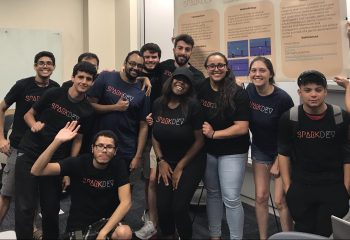Projects with Vanguard CDC and University of Michigan’s Taubman College of Architecture and Urban Planning will provide neighborhood residents with a new library and an attractive main street.
DETROIT — February 25, 2021 — The John S. and James L. Knight Foundation today announced nearly $2 million in support for projects that accelerate equitable growth in Detroit’s Historic North End. Knight support will be used to help transform the area into a pedestrian-friendly destination in partnership with Vanguard Community Development Corporation (CDC) and design a community-oriented library with the University of Michigan (U-M) Taubman College of Architecture and Urban Planning.
Knight’s commitment is part of its ongoing strategic focus to help advance the historically Black neighborhood, which is experiencing an influx of economic growth as local funders and community organizations invest in the area. Both North End projects will use Knight support to foster equitable and sustainable growth in the neighborhood.
The grants are just the first of many investments Knight plans to make in the area as part of its mission to build informed and engaged communities. Here’s a closer look at both projects:
- Vanguard Community Development Corporation ($1.5 million): to support equitable development in Detroit’s Historic North End by transforming the 10-block East Grand Boulevard streetscape, the gateway into the North End community, into a cohesive, attractive and pedestrian-friendly corridor. Vanguard will gather community input at every stage of the process as they work to redesign and beautify the street, including adding wayfinding and other signage.
- University of Michigan Taubman College ($405,000): to design and adaptively reuse an existing building on the property as a community-centered design library and meeting space, which will exist as part of the Oakland Avenue Urban Farm in Detroit’s North End. In partnership with Oakland Avenue Urban Farm (OAUF), the U-M Taubman College will use Knight support to transform a vacant residence into a community library and meeting space — one that’s run entirely with community support and input. Funds will also provide ongoing support for programming and staffing.
“We believe that you can’t invest in a place without investing in the people who live there,” said Nate Wallace, Knight’s Detroit program director. “These projects are helping the North End community shape its own future, build resiliency and feel more connected to the area, and we’re proud to help support them.”
Knight’s investment in the East Grand Boulevard project comes on the heels of its designation as a National Historic Main Street. Vanguard Community Development Corporation (CDC) will use Knight support to launch a three-year project to physically transform East Grant Boulevard, the gateway into the North End community.
“East Grand Boulevard is a historic promenade, and gateway into the North End,” said Pamela Martin Turner, Vanguard CDC president and CEO. “This project will transform East Grand into a beautiful, walkable, street that can be enjoyed by the entire community.”
The design of the community library project will be led by U-M Taubman College, which is working with Detroit-based architecture and urban design studio Akoaki to help OAUF reimagine and realize six acres of the North End. The facility will offer a meeting place for community organizations and Taubman College students and faculty to work together on design, planning, and development projects.
“Our hope is that this project offers a valuable resource to the North End and continues to build on all of the positive things happening in this community,” said Anya Sirota, associate dean at U-M’s Taubman College and co-principal of Akoaki. “This facility’s place as a piece of permanent infrastructure will provide the community and the university the opportunity to learn from one another for years to come and help realize the broader vision of a civic commons in the area.”
Knight’s commitment to the North End aims to support projects that reflect the community it serves by elevating projects that represent and serve Detroit’s majority Black population.
“The North End is at the dawn of a new, important era,” said Jerry Ann Hebron, a long-time North End resident, who is Oakland Avenue Urban Farm’s director. “As we build a place that more North End residents are involved with and proud of, and as more community needs are served, we know the North End will thrive.”
Knight’s investments are part of its mission to foster equitable, community-driven change that helps build access to local amenities, something that is needed and wanted by residents and helps attach them to their community. In fact, Knight’s 2019 Community Ties study shows why it’s important to invest in local amenities to help residents form stronger connections to their communities.
These projects are led by the North End community, dependent on engagement from and solutions by North End residents, and will help Knight continue to foster a strong relationship with the residents of the area.
For more on Knight’s work in Detroit, visit kf.org/detroit.
###
About the John S. and James L. Knight Foundation
Knight Foundation is a national foundation with strong local roots. We invest in journalism, in the arts, and in the success of cities where brothers John S. and James L. Knight once published newspapers. Our goal is to foster informed and engaged communities, which we believe are essential for a healthy democracy. For more, visit kf.org.
Contact: Roshni Neslage, Communications Officer, Knight Foundation, 305.908.2623, [email protected]
Photo (top): A scale model of proposed plans for the Oakland Avenue Urban Farm, courtesy of Akoaki.






